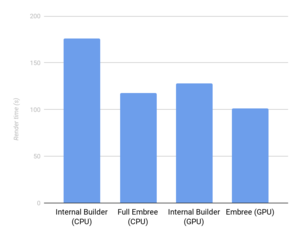User:Qmatillat/GSoC2019/FinalReport
GSoC 2019 Embree on GPU
This is the final report for the GSoC 2019 project: Embree on GPU.
All of the code can be found in this branch: soc-2019-embree-gpu, and in this diff D5522. It contain a patch that summarize all the change to Embree. Those change can also be found in this repository : github.com/tinou98/embree.
Work done
The creation of all the BVH structure are extracted from Embree internal structure, and support the existing following traversal features :
- instanced mesh
- motion blur
- curves (without motion blur)
Embree also support these new features that have been added to the traversal code :
- node that are only valid for a range of time
- linear interpolation of bounding box at traversal time
Remaining work
- Support for motion blur on curves
- The convert step is currently single threaded, and can benefit from multithreading.
- Improvement to creation of leaf: Creation of leaf still require some access to blender object data, and thus is slow.
- The shrink step can be optimized :
Embree has a BVH4 tree, but GPU expect a BVH2 tree, thus the conversion step create two inner node :
The computation of the two bounding box for the inner node, can be optimized (especially with unaligned node), see bvh_shrink.
Try it yourself
- Clone blender and checkout the
soc-2019-embree-gpu.
git clone git://git.blender.org/blender.git
git checkout soc-2019-embree-gpu
- Install dependencies, but force to build embree from source :
./blender/build_files/build_environment/install_deps.sh --with-embree --build--embree
- Install dependencies, but force to build embree from source :
mkdir build; cd build
cmake -DWITH_CYCLES_EMBREE=ON ../blender
make -j <N> install
- Enable Embree converter from Render panel : Performance » Acceleration Structure » BVH Builder » Embree, then convert
- Then render
Benchmark
The converter shows the best performances on the scenes with a deformation motion blur, but on other scene, it is usually around 10% slower.






